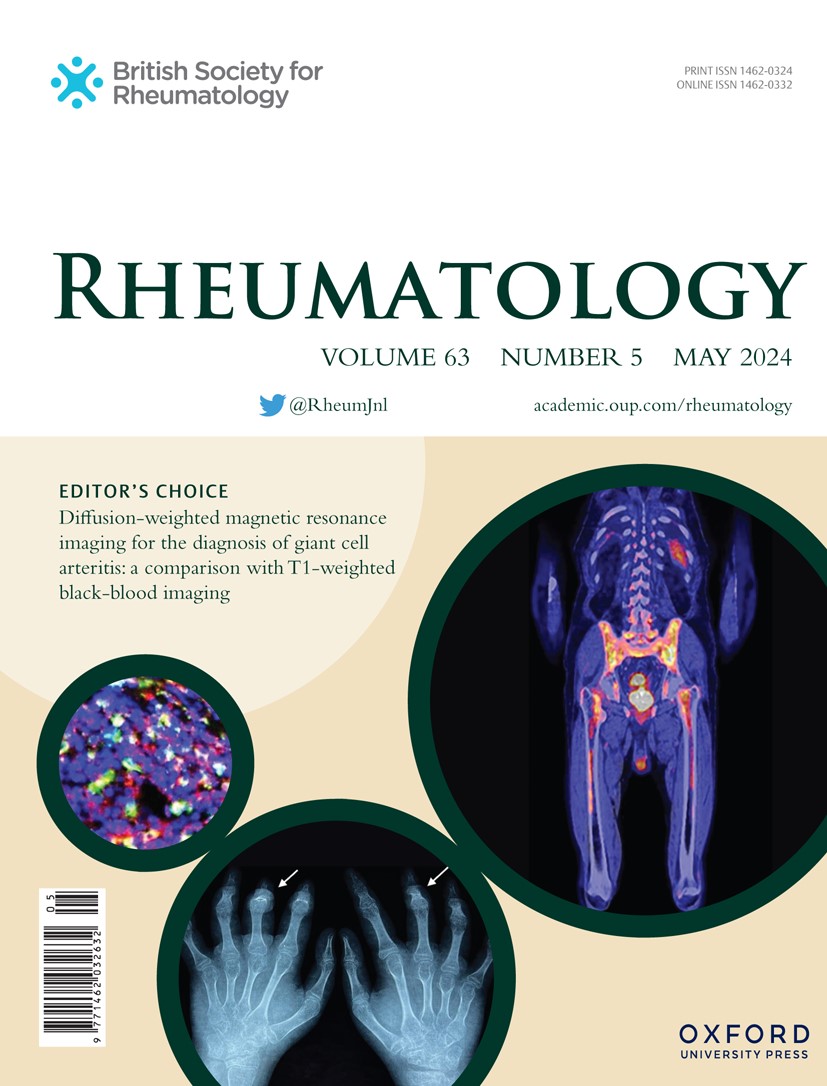Impact of dactylitis and enthesitis resolution on disease control in guselkumab-treated PsA patients with TNFi-IR: COSMOS post-hoc analysis.
IF 4.4
2区 医学
Q1 RHEUMATOLOGY
引用次数: 0
Abstract
OBJECTIVE To evaluate guselkumab efficacy on dactylitis resolution (DR) and enthesitis resolution (ER), and their impact on subsequent disease control, in patients with active psoriatic arthritis (PsA) and prior inadequate response to tumour necrosis factor inhibitors (TNFi-IR). METHODS In the Phase IIIb COSMOS trial, 285 adults with TNFi-IR PsA were randomized (2:1) to receive guselkumab 100 mg or placebo at Week (W)0, W4, then every 8 weeks until W44. The Dactylitis Severity Score (DSS) and Leeds Enthesitis Index (LEI) assessed dactylitis and enthesitis. This post-hoc analysis evaluated associations between W24 DR/ER and W48 achievement of stringent disease control measures using logistic regression. RESULTS At baseline, 103/285 (36.1%) patients had dactylitis (DSS ≥ 1) and 190/285 (66.7%) had enthesitis (LEI ≥ 1). Patients with dactylitis were more likely to have enthesitis, more joint (SJC/DAPSA) and skin involvement, higher PGA score, and lower BMI vs those without dactylitis. Patients with enthesitis were more likely to be female, and have dactylitis, more joints affected (SJC/TJC/DAPSA) and worse physical functioning (HAQ-DI/SF-36 PCS) vs those without enthesitis. Greater proportions of guselkumab- vs placebo-treated patients achieved DR/ER (W24: 44.8%/39.7% vs 25.0%/18.8%); rates increased through W48 among guselkumab-randomized patients (67.2%/55.6%). W24 resolution was associated with W48 achievement of stringent measures, including ACR50/70, DAPSA LDA/remission, PASI100, PASDAS LDA/VLDA, and MDA/VLDA (odds ratios: DR, 3.28-13.38; ER, 2.88-6.09). CONCLUSION Guselkumab treatment resulted in high DR/ER rates through W48 in TNFi-IR PsA patients. W24 DR/ER was associated with W48 disease control, providing valuable insights for clinical decision-making based on W24 treatment responses.在guelkumab治疗的PsA患者中,手指炎和鼻炎消退对疾病控制的影响,伴有TNFi-IR: COSMOS事后分析。
目的:评价古塞库单抗对活动性银屑病关节炎(PsA)和肿瘤坏死因子抑制剂(TNFi-IR)反应不足患者的指炎缓解(DR)和鼻炎缓解(ER)的疗效及其对后续疾病控制的影响。方法:在IIIb期COSMOS试验中,285名患有TNFi-IR PsA的成年人随机(2:1)在第0周、第4周接受100 mg的guselkumab或安慰剂,然后每8周接受一次,直到第44周。指炎严重程度评分(DSS)和利兹肠炎指数(LEI)评估指炎和肠炎。该事后分析使用逻辑回归评估了W24 DR/ER与W48实现严格疾病控制措施之间的关系。结果基线时,103/285例(36.1%)患者有指炎(DSS≥1),190/285例(66.7%)患者有鼻炎(LEI≥1)。与无指突炎的患者相比,患有指突炎的患者更有可能出现鼻炎、更多的关节(SJC/DAPSA)和皮肤受累、更高的PGA评分和更低的BMI。与没有溃疡的患者相比,溃疡患者更可能是女性,并且有指炎,更多的关节受影响(SJC/TJC/DAPSA)和更差的身体功能(HAQ-DI/SF-36 PCS)。古塞库单抗治疗与安慰剂治疗的患者实现DR/ER的比例更高(W24: 44.8%/39.7% vs 25.0%/18.8%);在guselkumab随机患者中,W48发生率升高(67.2%/55.6%)。W24的解决与W48达到严格措施相关,包括ACR50/70、DAPSA LDA/缓解、PASI100、PASDAS LDA/VLDA和MDA/VLDA(比值比:DR, 3.28-13.38; ER, 2.88-6.09)。结论:通过W48, uselkumab治疗可导致TNFi-IR PsA患者的高DR/ER率。W24 DR/ER与W48疾病控制相关,为基于W24治疗反应的临床决策提供了有价值的见解。
本文章由计算机程序翻译,如有差异,请以英文原文为准。
求助全文
约1分钟内获得全文
求助全文
来源期刊

Rheumatology
医学-风湿病学
CiteScore
9.40
自引率
7.30%
发文量
1091
审稿时长
2 months
期刊介绍:
Rheumatology strives to support research and discovery by publishing the highest quality original scientific papers with a focus on basic, clinical and translational research. The journal’s subject areas cover a wide range of paediatric and adult rheumatological conditions from an international perspective. It is an official journal of the British Society for Rheumatology, published by Oxford University Press.
Rheumatology publishes original articles, reviews, editorials, guidelines, concise reports, meta-analyses, original case reports, clinical vignettes, letters and matters arising from published material. The journal takes pride in serving the global rheumatology community, with a focus on high societal impact in the form of podcasts, videos and extended social media presence, and utilizing metrics such as Altmetric. Keep up to date by following the journal on Twitter @RheumJnl.
 求助内容:
求助内容: 应助结果提醒方式:
应助结果提醒方式:


